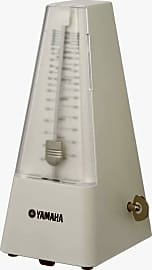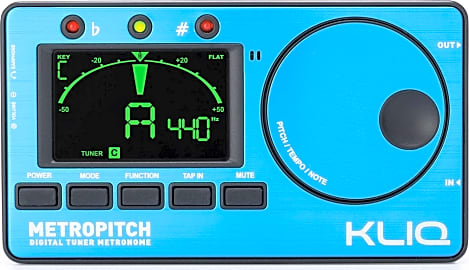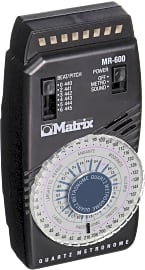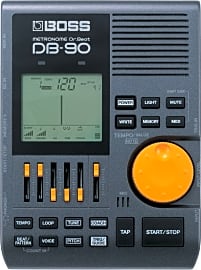The 10 Best Metronomes

This wiki has been updated 46 times since it was first published in April of 2015. Whether you're a composer or you're learning a new instrument, every musician can benefit from an accurate metronome. The reliable items on this list will help you keep perfect time as you work your way through practice pieces. Our selection represents a wide variety of options, from traditional wind-up models to high-tech, multifunctional digital devices. When users buy our independently chosen editorial choices, we may earn commissions to help fund the Wiki.
Editor's Notes
February 14, 2020:
Due to ongoing issues with its loudness, we have opted to remove the Korg TMR-50 at this time. It is just too quiet, which can be quite frustrating. The upgraded Korg TM-60, on the other hand, does not suffer from this issue, and is easy to use and affordably priced, to boot. For an alternative, consider the Kliq MetroPitch. Offered in several colors, it is a metronome/tuner with plenty of functions, although its advanced functions are slightly less intuitive to use than those found on some other models. We've also elected to remove the Cherub WSM-330 over occasional issues with its accuracy. Those who like the traditional pendulum style might instead consider the Yamaha MP-90, or, if the budget allows, the Wittner 811M. The latter is attractive enough to be worthy of display, although it has some plastic pieces — frustrating, given the cost.
For something different, there's the Soundbrenner Core Steel, which resembles a smart watch. Unlike a smart watch, though, you won't need to download a metronome app, as this wearable was made specifically to provide you with vibrating timekeeping feedback. It offers plenty of additional functionality, too, including a handy decibel meter.
Keep To The Beat
Practical applications for software metronomes include film scoring and digital music production.
Expressive forms of art are not necessarily meant to be structured or quantified. When learning how to paint, for example, an apprentice learns about the different styles of canvas, brushes, brushstrokes, and paint consistencies needed to create the most lifelike images. But at the end of the day, an artist's desires, personality, and time allow him to infuse his creation with his own views of culture and history without obsessing over the mechanics of what's involved in the process.
Professional singers or musicians are not always obsessed with the structural nature of their music or the notes they see on a page. Following the adaptation to a musical composition and the way it should be played, these professionals learn how to personalize the art form and make it their own in order to convey feeling to an audience. That is one of music's ultimate goals, but in order to get there the fundamentals still need to be taught, learned, and practiced. For the student or professional musician learning a new piece, a metronome can be an excellent tool to help keep them in time as they play and become accustomed to the nature of the composition.
A metronome is a device that produces audible and metrical beats or ticks per minute in order to keep a musician in proper time. The device is most useful as a training tool for students or any musician learning how to keep the right tempo (speed and pace of the notes played). Depending on the passage of music, it may require an increase or decrease in tempo. The device also encourages further development of one's internal sense of tempo. This means that a musician learns to recognize the appropriate moments to play fast or slow without having to depend on the metronome indefinitely.
While it is a great training tool, a common criticism for the device is that it also removes personality from the music being played. This defeats the point of conveying the feeling of music to an audience in the first place. We're not here to bash the metronome by any means, but it's important to recognize it as a tool for developing one's individual sense of musical instinct and not as an object of permanent dependence.
The three major types of metronome include mechanical, electronic, and software. Mechanical metronomes leverage an adjustable weight on the end of an inverted pendulum rod, which swings back and forth to keep the tempo consistent. When the weight is raised along the rod, the tempo will decrease. When the weight is lowered, the tempo will increase. These devices also have an internal component that produces a clicking noise as the pendulum swings to each beat. The visual cue of the pendulum swinging back and forth can be a significant advantage for a student who's just learning to play an instrument, as they can learn to anticipate the pendulum's movements.
The electronic metronome is typically battery-operated with a digital display that uses quartz crystal to maintain its accuracy. Many electronic metronomes have built-in dials or buttons to control the tempo, while others can produce several distinct sounds to represent different beats. Software metronomes can be an element of a larger musical sequencing system or they can exist as standalone programs. Practical applications for software metronomes include film scoring and digital music production.
A Brief History Of Metronomes
The earliest attempt to create a form of the metronome occurred in the ninth century with Andalusian inventor and musician Abbas ibn Firnas. By the late sixteenth century (1581), Galileo Galilei began studying the mathematical motion of the pendulum and discovered that pendulums (of any given length) would vibrate in the same time, whether their amplitude was large or small. This concept was referred to as isochronism and was applied to the mechanical clock, but it also provided insight into the development of the mechanical metronome.
This gave the device a multifunctional edge for incorporating additional features, such as accented beats and pitch tuning capability.
The first mechanical metronome was invented in 1696 by musical theorist Etienne Loulié with the use of an adjustable pendulum. Unfortunately, the device did not produce any sound, nor did it include an escapement for counting the pendulum's oscillations and keeping it in motion.
The practical mechanical metronome was developed by Amsterdam inventor Dietrich Nikolaus Winkel in 1814. Incorporating Winkel's ideas and manufacturing the device under his own name, Johann Nepomuk Maelzel added a scale to the device in 1816.
Modern-style metronomes became common with the harnessing of alternating current, which made possible the Franz electric metronome of 1938. This device featured a synchronous motor (similar to those used in electric clocks) used to control a tempo-beating hammer. It was produced (and remained popular) until 1994.
Beginning in the 1970s, the digital electronics age allowed for the development of the electronic metronome with microprocessor technology. This gave the device a multifunctional edge for incorporating additional features, such as accented beats and pitch tuning capability.
The Ideal Metronome
Whether one chooses an electronic or mechanical metronome is a personal choice. That said, if simplicity makes more sense to you, a mechanical device is a good way to go.
The best metronome assists you during practice and improves your skill by keeping you on point with respect to the appropriate tempo. However, it should be easy enough to shut off or stop when it's no longer needed. This doesn't devalue the metronome, but the device should be used in moderation, regardless of the type chosen. For that reason, there's no need to invest huge amounts of money in one full of bells and whistles. However, students who have trouble keeping time can benefit from an electronic metronome's ability to store various tempos for practice.
Some of the most cutting-edge electronic metronomes allow for the programming of custom beats, which comes in particularly handy if you're a drummer or a musician wishing to improvise a composition. Additionally, some metronomes can even detect pitch discrepancies, which can help you tune your instrument properly during practice sessions.















